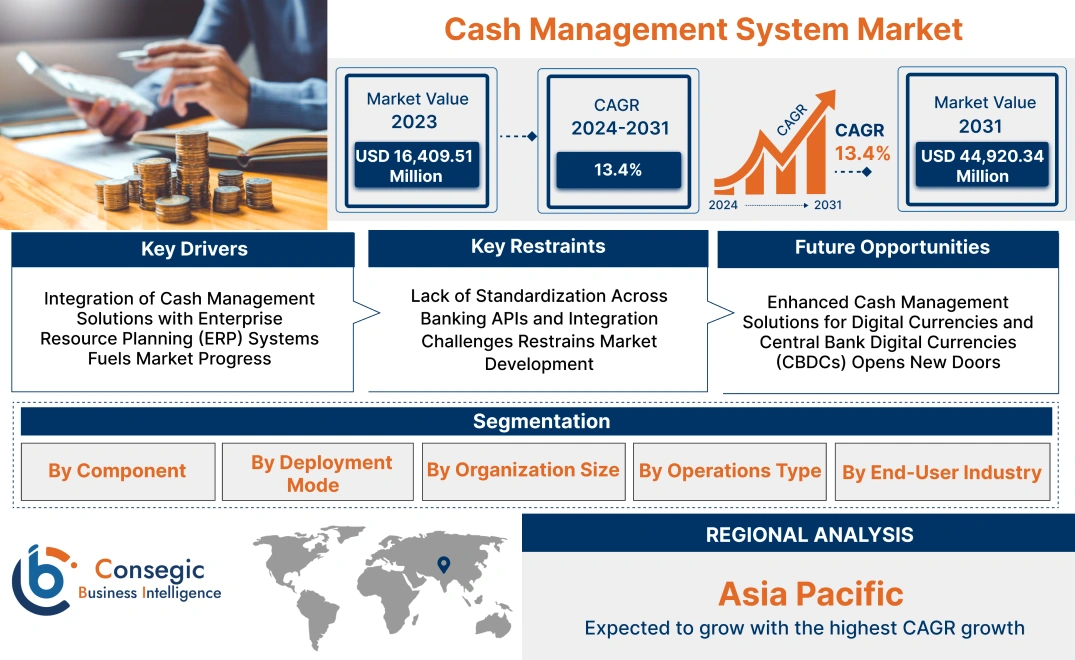- Summary
- Table Of Content
- Methodology
Cash Management System Market Size:
Cash Management System Market size is estimated to reach over USD 44,920.34 Million by 2031 from a value of USD 16,409.51 Million in 2023 and is projected to grow by USD 18,530.51 Million in 2024, growing at a CAGR of 13.4% from 2024 to 2031.
Cash Management System Market Scope & Overview:
A cash management system is a comprehensive software solution designed to handle an organization's cash flow, optimize liquidity, and streamline financial operations. These systems enable businesses to manage daily cash transactions, monitor cash positions, and automate processes like payment scheduling, reconciliation, and forecasting. With features such as real-time tracking, integrated reporting, and risk management capabilities, it helps organizations maintain better control over their financial resources and enhance overall efficiency. The application of these systems is widespread across industries like banking, retail, and corporate finance, where effective cash flow management is critical. The software supports various financial functions, including account management, cash flow forecasting, and transaction processing, all of which contribute to maintaining optimal liquidity levels and informed decision-making. Additionally, the integration of these systems with enterprise resource planning (ERP) software and banking solutions further enhances their utility by providing a unified financial management platform. End-users of cash management systems include banks, financial institutions, retail businesses, and corporate enterprises that seek to streamline their cash operations, improve financial visibility, and enhance treasury functions. These solutions are tailored to meet the specific needs of diverse industries, ensuring efficient cash handling and better financial oversight.
Cash Management System Market Dynamics - (DRO) :
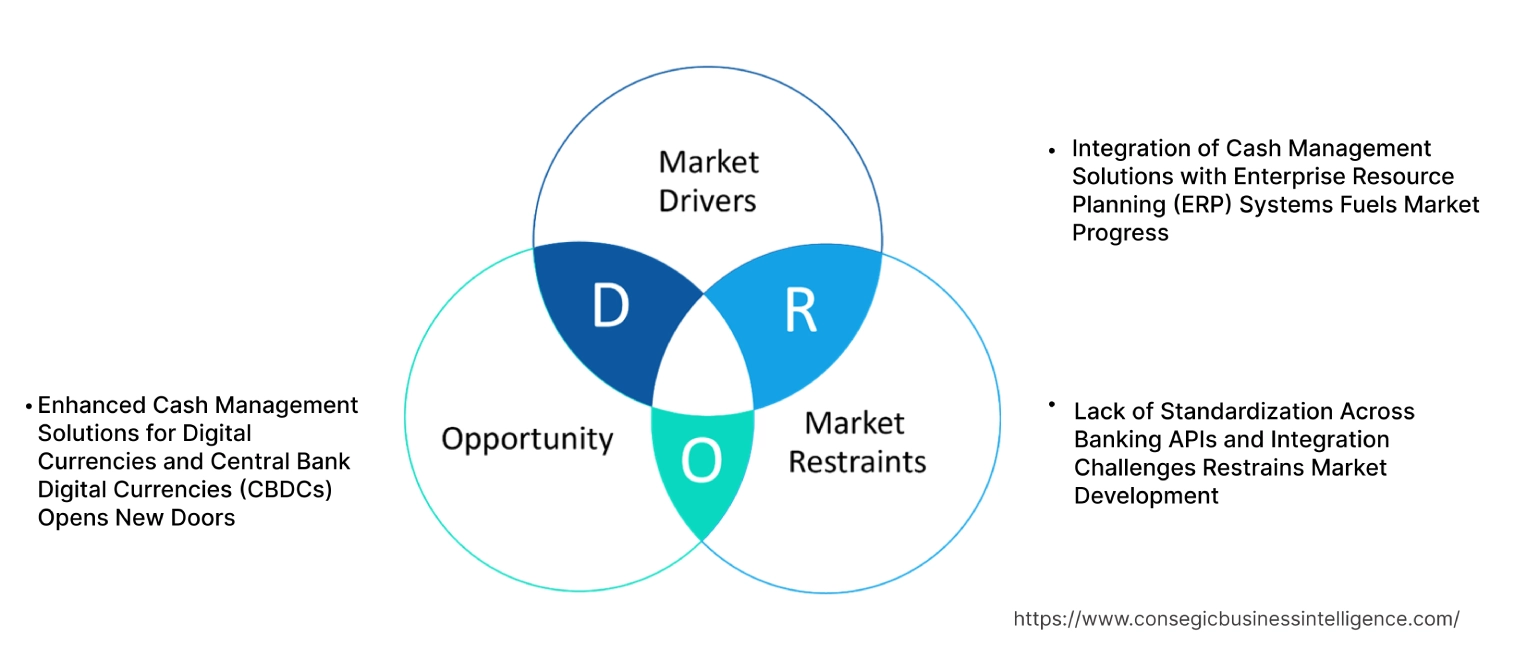
Key Drivers:
Integration of Cash Management Solutions with Enterprise Resource Planning (ERP) Systems Fuels Market Progress
Many organizations are adopting comprehensive financial platforms that integrate cash management functionalities with existing ERP software to streamline financial processes, enhance visibility, and reduce operational inefficiencies. By connecting cash management systems with ERP solutions, businesses achieve better synchronization of accounts payable, accounts receivable, and treasury functions. This integration provides a holistic view of financial data, enabling companies to automate cash flow forecasting, optimize working capital, and improve decision-making. The demand for seamless integration with ERP systems is particularly high among large enterprises and multinational corporations, where the complexity of financial transactions necessitates advanced, unified solutions. Thus, the aforementioned factors boost the cash management system market growth.
Key Restraints :
Lack of Standardization Across Banking APIs and Integration Challenges Restrains Market Development
A significant restraint in the market is the lack of standardization across banking APIs, which complicates integration efforts for businesses utilizing multiple banking partners. Each financial institution may use different API formats, security protocols, and data structures, making it difficult for companies to implement a unified cash management solution. The absence of standardized interfaces leads to inconsistencies in data synchronization, increased development costs, and longer implementation timelines. These integration constraints are particularly problematic for multinational corporations managing complex financial operations across various banks and geographies. The need to customize API integrations for each bank increases the risk of errors, reduces efficiency, and limits the scalability of cash management solutions. Thus, the lack of standardized banking APIs hinders the cash management system market demand.
Future Opportunities :
Enhanced Cash Management Solutions for Digital Currencies and Central Bank Digital Currencies (CBDCs) Opens New Doors
As central banks and financial institutions explore the implementation of CBDCs, businesses are looking for advanced cash management solutions that will accommodate digital currency transactions alongside traditional fiat currencies. Cash management platforms that support digital currency integration will offer features such as automated currency conversion, real-time digital wallet reconciliation, and compliance with digital currency regulations. The adoption of digital currencies by consumers and businesses is expected to increase, especially in regions with strong government support for CBDC initiatives. Cash management system opportunities emerge from delivering solutions that streamline the handling of digital and traditional currencies, establishing providers as leaders in the shifting financial ecosystem.
Cash Management System Market Segmental Analysis :
By Component:
Based on components, the Market is segmented into Software and Services.
The software segment accounted for the largest revenue share in 2023.
- The software component includes solutions like cash flow forecasting, cash position management, and payment processing, which are critical for automating and streamlining financial operations.
- Cash flow forecasting helps businesses predict future cash requirements, allowing for better planning and liquidity management.
- Cash position management software offers real-time visibility into cash balances, optimizing the utilization of funds across accounts and geographies.
- Payment processing solutions automate transactions, reducing manual errors and enhancing the speed of payments, particularly for large enterprises with high transaction volumes.
- As per cash management system market trends, the dominance of the software segment is attributed to its role in improving financial efficiency and visibility, meeting the increasing demand for automated financial management solutions.
The services segment is expected to register the fastest CAGR during the forecast period.
- Services include consulting, integration & deployment, and support & maintenance, which are essential for the successful implementation and operation of systems.
- Consulting services help organizations assess their financial processes, identify gaps, and tailor cash management solutions to fit their specific needs.
- Integration & deployment services ensure that cash management software is seamlessly integrated into existing financial systems, minimizing disruptions to business operations.
- Ongoing support & maintenance services provide updates, troubleshooting, and optimization, helping businesses maintain the effectiveness of their system.
- As per the cash management system market analysis, the growth of the services segment is driven by the increasing complexity of financial environments and the need for expert assistance in implementing comprehensive cash management solutions.
By Deployment Mode:
Based on deployment mode, the market is segmented into On-Premise, Cloud-Based, and Hybrid.
The cloud-based segment accounted for the largest revenue of 63.80% the total cash management system market share in 2023.
- Cloud-based cash management solutions offer scalability, flexibility, and lower upfront costs, making them a preferred choice for many organizations transitioning to cloud infrastructure.
- These solutions provide real-time access to financial data, enabling businesses to make informed decisions quickly and enhance cash flow visibility.
- Leading providers, including Oracle and SAP, offer robust cloud-based platforms, integrating advanced analytics and AI to optimize cash management processes.
- The development of the cloud-based segment is driven by the increasing adoption of cloud technologies and the need for scalable, cost-effective financial solutions.
- The dominance of the cloud-based segment is due to its ease of implementation, cost efficiency, and the growing preference among organizations for cloud-based financial software which further boosts the cash management system market growth.
The hybrid deployment segment is expected to register the fastest CAGR during the forecast period.
- Hybrid deployment combines on-premise and cloud-based solutions, offering the flexibility of cloud services while maintaining control over critical financial data on-premise.
- This model is particularly attractive to large enterprises with stringent compliance requirements and complex financial operations that require a customized approach.
- The increasing trend of adopting multi-cloud strategies and the need for secure, flexible financial management systems are driving the growth of hybrid deployments.
- As per cash management system market trends, the hybrid deployment segment is projected to grow rapidly due to its ability to meet diverse business needs while balancing cost and data security.
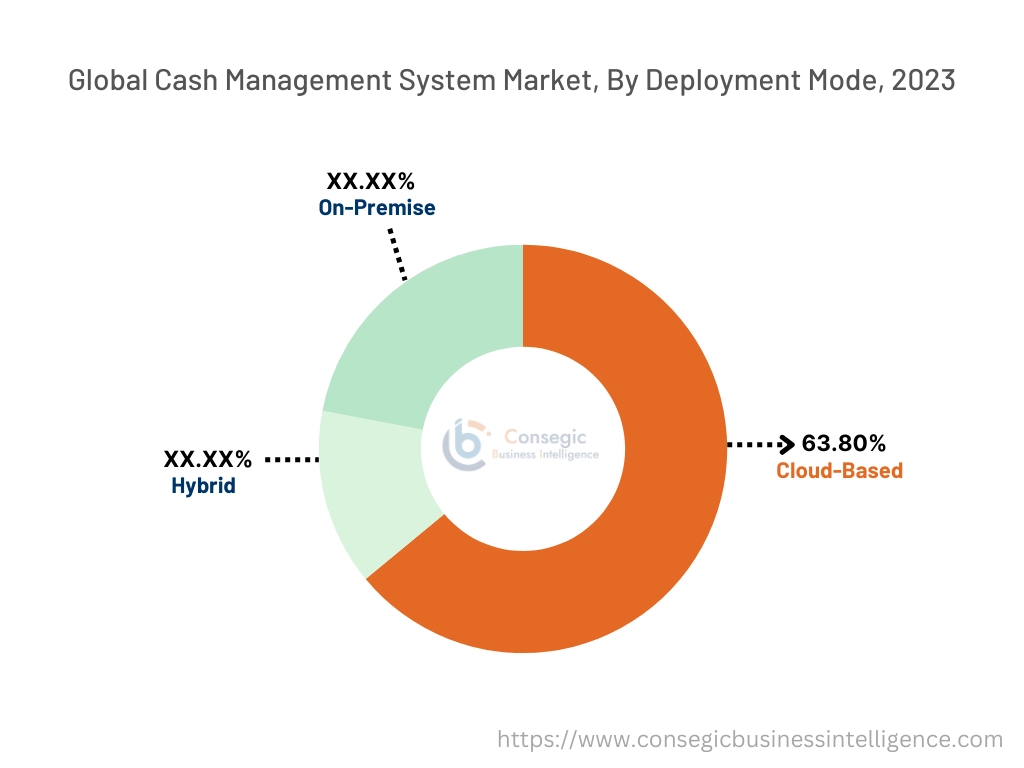
By Organization Size:
Based on organization size, the market is segmented into Small & Medium Enterprises (SMEs) and Large Enterprises.
The large enterprises segment accounted for the largest revenue share in 2023.
- Large enterprises typically manage extensive cash flows and complex financial operations, requiring advanced cash management solutions to streamline processes and ensure efficient liquidity management.
- These organizations invest in comprehensive cash management systems that offer features like automated reporting, multi-currency handling, and advanced analytics, enhancing decision-making capabilities.
- The increasing focus on digital transformation and the adoption of automated financial processes contribute to the strong demand for cash management solutions among large enterprises.
- The dominance of the large enterprises segment is due to significant investments in financial technology and the need for scalable solutions to manage complex financial transactions which boosts the cash management system market demand.
The SME segment is expected to register the fastest CAGR during the forecast period.
- SMEs are increasingly adopting cash management systems to enhance operational efficiency, optimize cash flow, and gain better financial control without incurring high infrastructure costs.
- Cloud-based solutions are particularly appealing to SMEs, offering flexibility, scalability, and lower costs compared to traditional on-premise systems.
- The growing awareness of the benefits of cash management solutions and the push towards digital adoption are driving the progress of this segment.
- As per cash management system market analysis, the SME segment is expected to grow rapidly, supported by the increasing availability of affordable, scalable cash management solutions tailored to smaller businesses.
By Operations Type:
Based on operations type, the market is segmented into Balance & Transaction Reporting, Cash Flow Forecasting, Corporate Liquidity Management, Payables, Receivables, and Others.
The cash flow forecasting segment held the largest revenue share in 2023.
- Cash flow forecasting tools enable businesses to predict future cash inflows and outflows, helping them make informed financial decisions and avoid liquidity issues.
- This capability is critical for maintaining financial stability, especially in industries with high volatility or seasonal fluctuations in cash flow.
- The increasing focus on improving cash visibility and the need for accurate financial planning are driving the demand for cash flow forecasting solutions.
- The dominance of the cash flow forecasting segment is due to its essential role in strategic financial management and enhancing liquidity control further encouraging the cash management system market expansion.
The corporate liquidity management segment is expected to register the fastest CAGR during the forecast period.
- Corporate liquidity management solutions help businesses optimize their cash reserves, ensuring that they have adequate funds to meet operational needs while maximizing returns on idle cash.
- These tools provide real-time visibility into cash balances across accounts, enabling efficient cash allocation and investment strategies.
- The rapid growth of this segment is driven by the increasing emphasis on effective liquidity management, especially in uncertain economic conditions.
- The analysis of segmental trends depicts that the corporate liquidity management segment is projected to grow quickly as businesses focus on optimizing cash utilization and enhancing financial stability.
By End-User Industry:
Based on end-user industry, the market is segmented into Banking, Retail, Healthcare, Manufacturing, and Government & Public Sector.
The banking segment accounted for the largest revenue of the total cash management system market share in 2023.
- Banks are major users of cash management systems, utilizing them to optimize cash flow, manage liquidity, and provide efficient services to corporate clients.
- These solutions help banks automate complex financial processes, reduce manual errors, and enhance overall cash visibility, improving customer satisfaction.
- The dominance of the banking segment is due to its extensive use of cash management tools for efficient fund allocation and risk mitigation which facilitates the cash management system market expansion.
The retail segment is expected to register the fastest CAGR during the forecast period.
- Retailers use cash management systems to streamline cash handling, optimize working capital, and improve financial planning across multiple locations.
- The increasing adoption of digital payments and the need for efficient cash reconciliation are driving the demand for cash management solutions in the retail sector.
- The growth of the retail segment is supported by the shift towards digital financial management and the extension of e-commerce further boosting the cash management system market opportunities.
Regional Analysis:
The regions covered are North America, Europe, Asia Pacific, the Middle East and Africa, and Latin America.
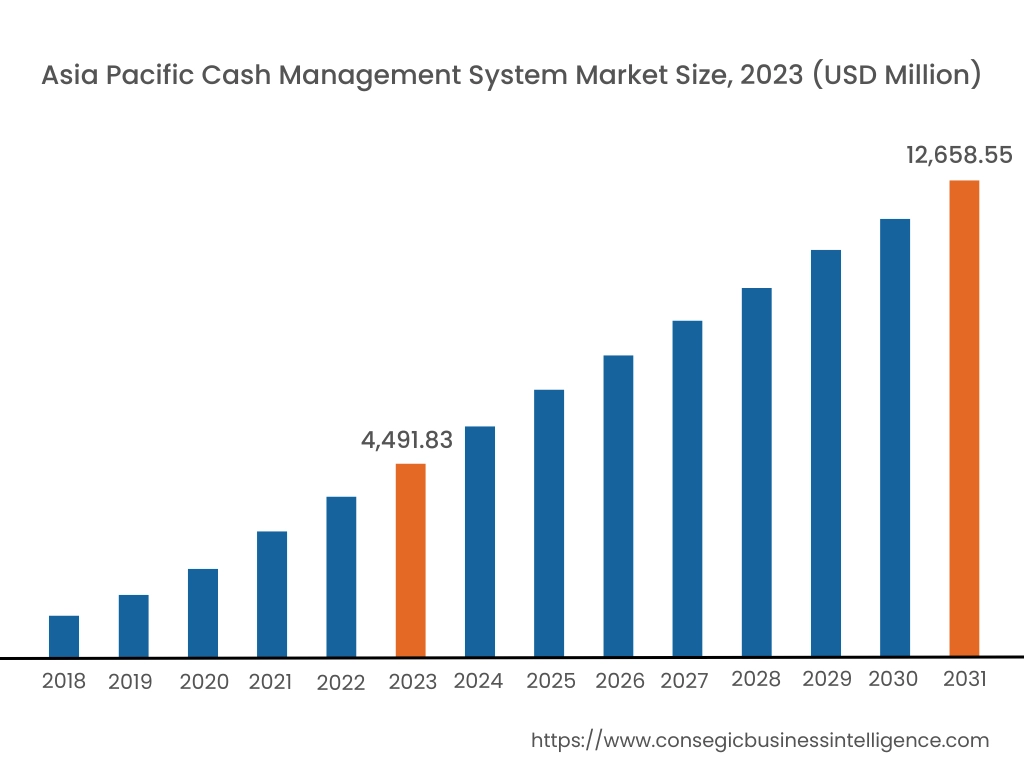
Asia Pacific region was valued at USD 4,491.83 Million in 2023. Moreover, it is projected to grow by USD 5,084.87 Million in 2024 and reach over USD 12,658.55 Million by 2031. Out of these, China accounted for the largest share of 32.7% in 2023. Asia-Pacific is the fastest-growing region in the market, fueled by rapid economic development, the rise of digital banking, and expanding corporate sectors in China, Japan, and India. The region's increasing focus on automation in cash handling and treasury operations drives the adoption of advanced cash management solutions. China's burgeoning financial sector and India's push towards digital payments and banking efficiency contribute to market expansion.
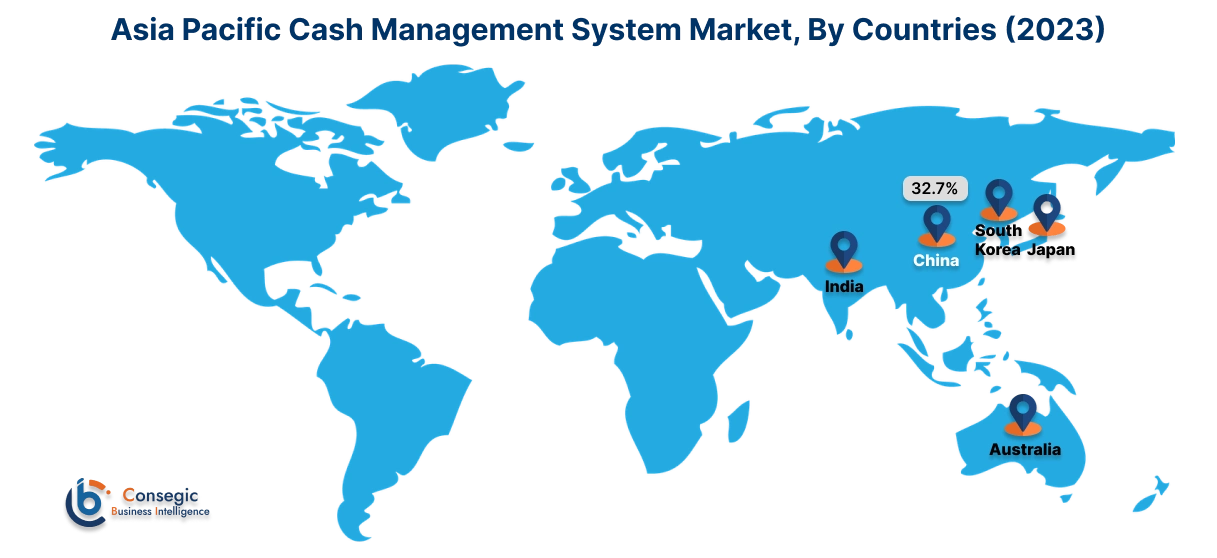
North America is estimated to reach over USD 15,178.58 Million by 2031 from a value of USD 5,618.48 Million in 2023 and is projected to grow by USD 6,337.76 Million in 2024. North America holds a dominant position in the market, driven by a high level of financial digitization and sophisticated banking infrastructure. The U.S., in particular, leads the market with significant adoption across banking, retail, and corporate sectors, emphasizing the need for efficient cash handling and transaction processing solutions. The push towards automation and integration of AI for predictive analytics in cash management enhances market growth.
Europe is a significant player in the market, with strong contributions from countries like Germany, France, and the UK. The market benefits from the region's focus on optimizing cash flow operations and streamlining financial processes in line with PSD2 (Payment Services Directive 2) regulations. European businesses are increasingly adopting cash management solutions to enhance liquidity management and financial transparency. The widespread use of integrated software for treasury management and enhanced compliance measures drives growth.
The Middle East & Africa (MEA) region is experiencing steady progress in the market, especially in Saudi Arabia, the UAE, and South Africa. Development in this region is supported by increasing investments in financial infrastructure and a strong push towards digitizing banking operations as part of national transformation plans like Saudi Vision 2030. Banks and financial institutions are adopting automated cash management solutions to improve efficiency and customer service.
Latin America is an emerging market with Brazil and Mexico driving adoption. The region's financial sector is focusing on improving cash flow visibility and reducing operational risks, supported by increased digitization and modern banking reforms. Brazil's emphasis on integrating real-time payments and Mexico's initiatives to enhance financial inclusivity boost the market for cash management solutions.
Top Key Players & Market Share Insights:
The Cash Management System market is highly competitive with major players providing products and services to the national and international markets. Key players are adopting several strategies in research and development (R&D), product innovation, and end-user launches to hold a strong position in the global Cash Management System market. Key players in the Cash Management System industry include –
- Q2 Holdings, Inc. (USA)
- Oracle Corporation (USA)
- Bottomline Technologies (USA)
- AccessPay (UK)
- HighRadius Corporation (USA)
- Fiserv, Inc. (USA)
- FIS Global (USA)
- Kyriba Corporation (USA)
- TreasuryXpress (USA)
- Finastra (UK)
Recent Industry Developments :
Product Enhancements:
- In September 2023, Citi introduced advanced digital asset services for its institutional clients, focusing on tokenized deposits and smart contracts. It also enhances cash management for institutional clients. By utilizing tokenized deposits, the solution streamlines liquidity management and payment processes, improving settlement efficiency. Smart contracts automate workflows, reducing manual intervention and enhancing real-time tracking of transactions. These advancements allow institutional clients to manage funds across borders seamlessly, optimize working capital, and reduce operational risks.
Partnerships & Collaborations:
- Indian Bank partnered with Intellect Design Arena to implement an advanced AI-powered cash management system. This solution aims to enhance transaction processing, liquidity management, and operational efficiency for the bank and its customers. By leveraging AI, the system facilitates seamless integration, automation, and real-time insights, offering a comprehensive platform to optimize cash flows and improve overall financial management for corporates and institutions.
Product Launches:
- In November 2024, DebtBook launched a new cash management solution designed to empower treasury teams by providing better visibility and control over financial operations. This solution integrates seamlessly with existing workflows, offering tools for managing cash flows, tracking investments, and optimizing financial strategies. It aims to enhance decision-making through advanced analytics and real-time insights, improving overall efficiency and financial health for organizations.
Contracts:
- In March 2024, Aurionpro announced that the State Bank of India (SBI) has selected iCashpro+, its advanced cash management and transaction banking platform. This platform aims to enhance SBI's capabilities in cash management by offering scalable, AI-driven solutions tailored for real-time payments, efficient liquidity management, and seamless transaction banking services. The adoption of iCashpro+ reflects SBI's commitment to integrating modern technology for improved financial operations and customer experience.
Cash Management System Market Report Insights :
| Report Attributes | Report Details |
| Study Timeline | 2018-2031 |
| Market Size in 2031 | USD 44,920.34 Million |
| CAGR (2024-2031) | 13.4% |
| By Component |
|
| By Deployment Mode |
|
| By Organization Size |
|
| By Operations Type |
|
| By End-User Industry |
|
| By Region |
|
| Key Players |
|
| North America | U.S. Canada Mexico |
| Europe | U.K. Germany France Spain Italy Russia Benelux Rest of Europe |
| APAC | China South Korea Japan India Australia ASEAN Rest of Asia-Pacific |
| Middle East and Africa | GCC Turkey South Africa Rest of MEA |
| LATAM | Brazil Argentina Chile Rest of LATAM |
| Report Coverage |
|
Key Questions Answered in the Report
How big is the Cash Management System market? +
Cash Management System Market size is estimated to reach over USD 44,920.34 Million by 2031 from a value of USD 16,409.51 Million in 2023 and is projected to grow by USD 18,530.51 Million in 2024, growing at a CAGR of 13.4% from 2024 to 2031.
What specific segmentation details are covered in the Cash Management System Market report? +
The Cash Management System market report includes segmentation details for component (software, services), deployment mode (on-premise, cloud-based, hybrid), organization size (small & medium enterprises and large enterprises), operations type (balance & transaction reporting, cash flow forecasting, corporate liquidity management, payables, receivables, others), end-user industry (banking, retail, healthcare, manufacturing, government & public sector), and region.
Which is the fastest-growing component in the Cash Management System market? +
The services segment is expected to register the fastest CAGR during the forecast period, driven by the increasing complexity of financial environments and the growing demand for expert assistance in implementing and maintaining cash management solutions.
Who are the major players in the Cash Management System market? +
The major players in the Cash Management System market include Q2 Holdings, Inc. (USA), Oracle Corporation (USA), Bottomline Technologies (USA), AccessPay (UK), HighRadius Corporation (USA), Fiserv, Inc. (USA), FIS Global (USA), Kyriba Corporation (USA), TreasuryXpress (USA), and Finastra (UK).
